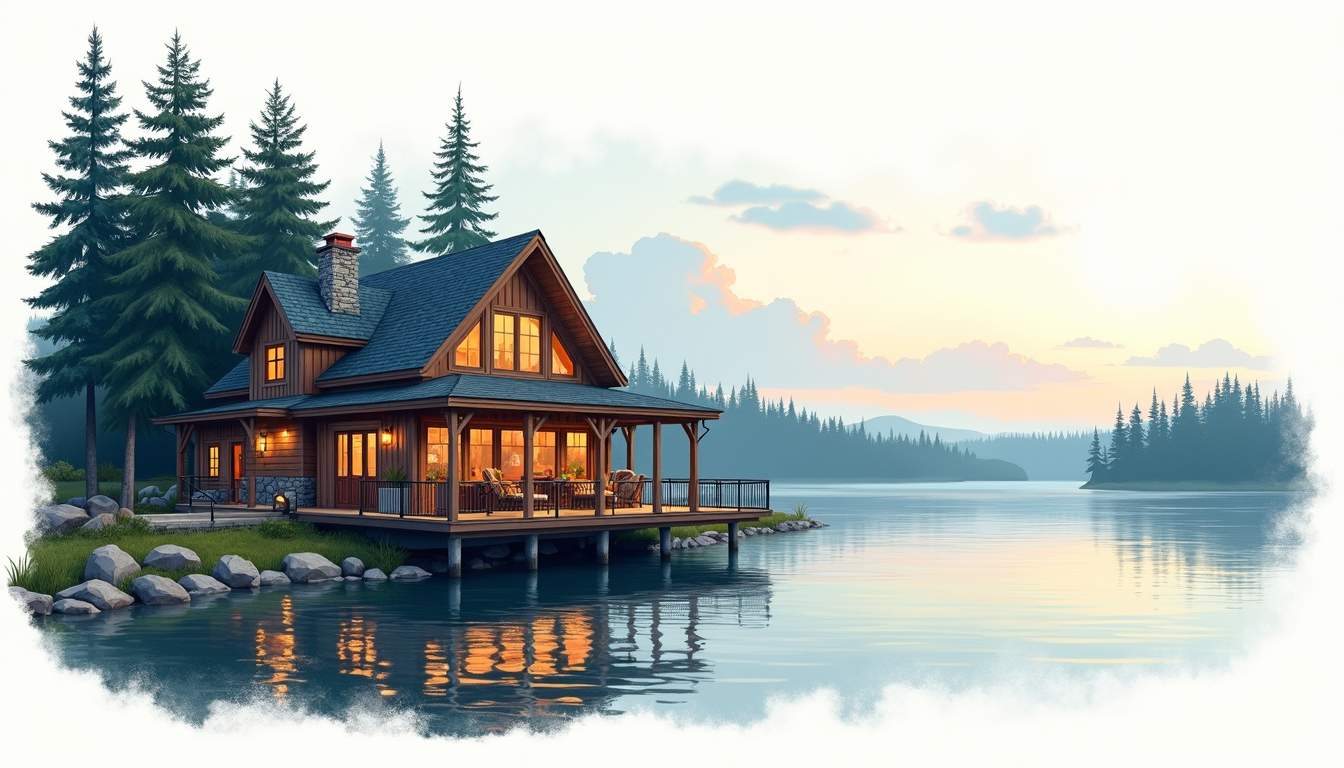
Lakefront property promises a special combination of serenity and style: the quiet lap of water against shore, wide-open views, and the ability to step from a designer kitchen onto a private dock. Luxury lakehouse living elevates those pleasures with thoughtful architecture, high-end finishes, and amenities tailored to leisure. This guide explores how to approach design, site planning, lifestyle considerations, and long-term upkeep so a lakehouse isn't just beautiful, but enduringly livable.
Location is the anchor of lakefront luxury. Consider water quality, seasonal water level changes, depth for boating, and public access policies. A pristine, deep lake with minimal boat traffic supports clearer water and more recreational options, while smaller lakes can offer greater privacy and calmer conditions for paddle sports.
Lot orientation matters as much as lake characteristics. A west-facing lot delivers spectacular sunsets over the water, while an east-facing property offers morning light and cooler afternoons. Topography affects foundation costs and landscaping possibilities—flat lots simplify outdoor living, while sloped lots can create dramatic walkouts and views.
Beyond these factors, also evaluate the surrounding community and amenities. Proximity to local marinas, restaurants, and hiking trails can enhance the lifestyle appeal. Additionally, consider the potential for future development in the area to ensure your privacy and view won’t be compromised.
It’s also wise to assess the typical wind patterns and prevailing weather conditions on the lake. For example, some lakes experience strong afternoon breezes that can influence water sports or dock placement. Taking note of seasonal variations like ice formation or algae blooms helps anticipate maintenance and recreational opportunities year-round.
Understand local zoning rules, lakeside building setbacks, and any homeowner association covenants before committing. Riparian rights, dock permissions, and sewage rules vary widely by jurisdiction. Early conversations with local permitting offices prevent costly redesigns and ensure docks, boathouses, and seawalls will be allowed.
In some regions, there may be limitations on watercraft types or motor sizes allowed on the lake, influencing how you plan your boating activities. Review any noise ordinances or restrictions on nighttime lighting that could affect your enjoyment of the property.
Preservation of shoreline vegetation reduces erosion and maintains water quality. Fragile wetlands or protected species could limit development; incorporating native plants and rain gardens mitigates impact while creating a natural aesthetic. Assess flooding risk and insurance requirements; elevated designs or flood-adapted foundations may be necessary in some areas.
Additionally, consider the role of invasive species management in the lake's ecosystem health. Engaging with local environmental groups can offer resources and guidance to protect both the lake and your property. Utilizing permeable driveway materials and minimizing impervious surfaces further helps to reduce runoff and protect water clarity.
Luxury lakehouses range from modern glass-and-steel structures to rustic timber-and-stone retreats. The key is coherence between the building and its setting—materials, rooflines, and window placement should reinforce the connection to the water rather than compete with it.

Large windows and operable walls are signature elements. Floor-to-ceiling glazing captures panoramic views and natural light, while sliding or folding doors expand living areas onto terraces. However, glass must be balanced with thermal performance and privacy; high-performance glazing, deep overhangs, and landscape buffers address comfort and glare.
Successful lakehouses blur boundaries between interior and exterior. Covered porches, screened rooms, and wide terraces allow enjoyment of the lake in varied weather. Designing continuous flooring surfaces or aligning thresholds visually connects rooms to docks and patios. Outdoor fireplaces, kitchens, and baths extend living areas year-round.
Durability is paramount in lakeside environments. Salt-free freshwater still exposes exteriors to humidity, sun, and seasonal storms. Choose rot-resistant woods, marine-grade metals, stone, and composite decking. Inside, prioritize finishes that resist moisture and wear—engineered hardwood, porcelain tile, and high-performance fabrics keep spaces elegant and low-maintenance.
High-end lakehomes incorporate amenities that support leisure, wellness, and hosting. A private dock with boat lift, integrated watercraft storage, and easy-launch paddle craft areas maximizes enjoyment of the lake. Consider a covered boathouse for added protection and aesthetic integration.
Wellness features such as spa bathrooms, saunas, and lakeside hot tubs add restorative value. For active households, private fitness studios, swimming pools, or tennis courts coexist with the natural workout provided by kayaking or hiking nearby trails.
Open-plan kitchens with professional-grade appliances, large islands, and scullery or butler's pantries support effortless entertaining. Outdoor kitchens adjacent to dining terraces enable al fresco meals at sunset. Guest suites or separate cottages provide privacy for visitors, enhancing long-term enjoyment and rental potential.
Integrating smart systems brings convenience and safety to remote lake properties. Automated shading, HVAC zoning, and pool controls reduce energy use and maintain comfort when the house is unoccupied. Surveillance cameras, motion-sensor lighting, and remote monitoring deter theft while allowing owners to check the home from afar.
Landscape design at the water's edge should combine utility, beauty, and ecological sensitivity. Native plantings create habitat, stabilize banks, and reduce maintenance. Terraced lawns, stepping stones, and pathways provide access while minimizing erosion. Hardscape materials should be chosen for slip resistance and durability.
Private docks are both functional and design features; floating docks adapt to water level changes, while fixed docks can feel more permanent and anchored. Lighting along paths and docks increases safety without disrupting nocturnal wildlife if done with low-glare, downward fixtures.
Shoreline stabilization techniques balance structural needs with habitat preservation. Engineered sea walls offer strong protection against erosion but can alter wave patterns and habitat. Riprap—layered stone—provides a more natural look while resisting washout. Where possible, living shorelines that combine native plantings with subtle structural elements provide resilience and ecological benefits.
Comfortable, weatherproof outdoor rooms create the sense of an extended interior. Retractable screens, operable glass, and well-planned drainage make these spaces usable through seasons. Furnishings should be marine-grade or treated for mold resistance, and storage drawers or benches help manage cushions and gear.
Sustainability is increasingly a priority for luxury homes. Passive solar orientation, high-performance insulation, and energy-efficient glazing lower operational costs and environmental impact. Solar panels can be sited on roofs or discreet ground arrays where permitted, and battery storage smooths variability for off-grid or semi-remote sites.
Water management is crucial at lake properties. Rainwater harvesting systems can supplement irrigation, and efficient fixtures reduce strain on septic or municipal systems. On-site wastewater treatment options are improving; engineered systems reduce nutrient runoff that can harm lakes.
Specifying responsibly sourced timber, recycled-content composites, and low-VOC finishes improves indoor air quality and reduces the project's ecological footprint. Local stone and materials reduce transportation emissions and help the structure visually belong to its context.
Promote low-impact lake recreation by providing storage and access tailored to canoes, kayaks, and paddleboards. These activities create less wake and disturbance than large motorboats and allow greater enjoyment of quiet coves and birdlife.
Owning a luxury lakehouse involves proactive maintenance and prudent financial planning. Regular inspections of roofs, docks, and mechanical systems prevent small issues from becoming costly. Seasonal tasks include winterizing systems where applicable, clearing gutters, and treating wood surfaces to protect against moisture.

Insurance requirements for waterfront homes can be more complex. Flood insurance, windstorm coverage, and specialized policies for docks or boathouses should be reviewed annually. Working with agents familiar with lakeside properties ensures adequate protection for replacement costs and liabilities.
Many lakehouse owners offset costs by renting the property part-time. A professional property manager handles bookings, cleaning, maintenance, and guest communications, safeguarding the home during absences. Well-defined rental rules and high-quality guest experiences protect the investment's value and reputation.
Storm preparedness mitigates risk. Secure outdoor furniture and watercraft, install hurricane straps or reinforced fastenings where recommended, and maintain an emergency plan that includes evacuation routes and contact lists. Elevating utilities and installing backflow preventers for drainage systems reduce vulnerability to high water events.
Lakefront real estate often commands a premium, but value varies based on lake health, accessibility, and resale market dynamics. Consider long-term appreciation, tax implications, and seasonal demand. Investing in high-quality construction and timeless finishes tends to yield stronger resale performance than chasing fleeting trends.
Cost estimates for luxury lakehouses should account for specialized systems: docks and boathouses, enhanced foundations, shoreline stabilization, and robust mechanicals. Budgeting for landscaping and exterior lighting is important; lakeside curb appeal is as noticeable as onshore facades.
Property taxes on lakefront parcels can be higher; assess the tax history before purchase. Zoning may affect rental rights or permissible structures. Work with real estate professionals experienced in waterfront transactions to navigate these factors and uncover potential incentives or restrictions.
A successful luxury lakehouse balances functionality, beauty, and respect for the landscape. Thoughtful planning from site selection through materials and systems ensures daily life is effortless and the property endures. Prioritizing views, indoor-outdoor connectivity, and resilient design creates a home that feels at once refined and rooted in nature.

Every lake and owner is unique, but common threads run through the best lakehouses: strong relationships with the water, spaces that invite shared moments, and thoughtful details that make maintenance simple. With careful choices and a long-term perspective, lakefront living can be an elegant, restorative way of life for years to come.
Embrace the perfect blend of lakefront living and resort-style luxury at Tennessee National. Nestled in Tennessee’s stunning landscapes, our gated community offers exclusive access to a Greg Norman Signature Golf Course, private marina, waterfront dining, and over 20 member amenities. Whether you desire a move-in ready home or a custom build, Tennessee National is designed to elevate your lakehouse experience. Schedule a private tour today and begin making unforgettable memories in a community that defines timeless luxury.